Music notation used on this site
Indian classical music, including bhajans played on instruments like the sitar, has traditionally been passed down through oral instruction from guru to shishya (master to student). This oral tradition has prioritized direct transmission over written notation, resulting in limited emphasis on formalizing musical scores. Although musicians and musicologists in both Carnatic and Hindustani traditions have attempted to standardize notation systems over the years, these efforts have seen only partial success. The lack of universal acceptance across different schools of music highlights the challenges in creating a notation system that accommodates the rich intricacies of ragas, talas, and improvisational elements inherent in the tradition.
When it comes to playing bhajans on the sitar, existing notation methods fall short in capturing the devotional nuances, subtle embellishments (gamakas and meends), and rhythmic variations that define the genre. Bhajans often incorporate fluid transitions between notes and intricate melodic phrases that are difficult to represent with conventional notation. As a result, there is a pressing need for enhanced notation techniques that can more accurately convey these elements while remaining accessible to musicians. Improved notation would not only aid in preserving bhajans but also facilitate learning and collaboration among artists, ensuring the tradition thrives in both contemporary and future contexts.
The notation described here builds on earlier works by legends of Indian music such as Pandit Vishnu Narayan Bhatkhande and Pandit Ravi Shankar of the Hindustani tradition, and Brahmasri Subbarama Diksita of the Carnatic tradition. Some modifications have been made to their notation styles for adaptation to the Sitar, particularly to better capture the nuances in gamakas.
| Symbol | Name | Alt. Name | Usage Example | Explanation |
|---|---|---|---|---|

|
Svara | Note |
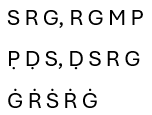
|
These represent the natural or shuddha’ notes of Hindustani music, i.e. Sa, Re, Ga, Ma, Pa, Dha, Ni. These are equivalent to the major notes C, D, E, F, G, A, B in the western scale. A dot (.) placed above the note indicates that the note belongs to the higher octave, while a dot placed under the note means that the note is played in the lower octave. A comma may sometimes be used to separate musical phrases. |

|
Svara | Note |
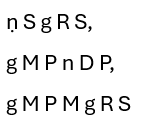
|
Lower case letters are used to represent sharp or flat variants of notes. Notice that while r, g, d, n represent flat or ‘komal’ Re, Ga, Dha, Ni svaras respectively, ‘m’ represents the sharp or ‘tivra’ Ma svara. A dot (.) placed above the note indicates that the note belongs to the higher octave, while a dot placed under the note means that the note is played in the lower octave. A comma may sometimes be used to separate musical phrases. |

|
Da | Da |

|
A vertical line that appears below a svara indicates that the svara should be played with the ‘Da’ stroke of the mizraab (a steel pluck that is worn on the right index finger) |

|
Da | Da |

|
A Da stroke with a horizontal line across the top half, indicates that the mizraab is struck harder for a greater emphasis on the svara. |

|
Ra | Ra |
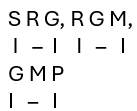
|
A horizontal line that appears below a svara indicates that the svara should be played with the ‘Ra’ stroke of the mizraab (a steel pluck that is worn on the right index finger). |

|
Ra | Ra |
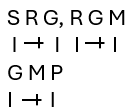
|
A Ra stroke with a vertical line across the right half, indicates that the mizraab is struck harder for a greater emphasis on the svara. Often the stroke is so hard that the sympathetic strings below the main string may also be struck. |

|
Diri | Diri |
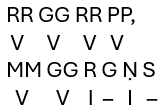
|
Appears below two svaras to indicate that the svaras are played with the ‘Da’ and ‘Ra’ strokes of the mizraab in quick succession. |

|
Meend | Bend |

|
A combination of notes played by pulling the string sideways, perpendicular to a fret. The first note in the meend is played with a Da or Ra stroke, following which the string is pulled sideways to produce other notes through sustenance of the sound. A meend is indicated by a curved line drawn on the top of the svaras. Meends can be simple - involving two notes, or complex – involving multiple musical phrases. |

|
Adhaar Svara | Anchor Note |

|
A svara that appears at the top of a meend symbol is known as the “adhaar svara” or the foundational note for the meend. This is the note where the string is pulled to produce the meend. When the meend consists of two notes, the adhaar svara is not explicitly shown. In this case, intuitively, the lower of the two notes (on the scale) is the adhaar svara. |

|
Sankeerna Meend | Complex Bend |
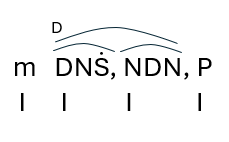
|
A complex meend consisting of two or more meends originating from the same adhaar svara. An overarching meend symbol representing a Misra Meend, binds the individual meends to form a continuous musical phrase – all originating from the adhaar svara of the overarching meend. |

|
Ghaseet | Slide |
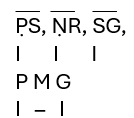
|
A gliding or sliding technique where the finger slides smoothly along the string to produce a continuous transition between two or more svaras in a group, starting from the first to the last svara. A Ghaseet invariably starts with a ‘Da’ stroke on the first svara and the sound produced by the stroke is sustained through the last svara in the group. |

|
Ched | Cut |

|
A soft plucking of the string that may or may not be accompanied by a stoke of the mizraab. When this symbol appears above two svaras, the following action is performed: with the index finger on the second svara and the middle finger on the first svara, the string is softly plucked with the middle finger to sound the first svara followed by the second svara. The plucking may be accompanied by a stroke of the mizraab to emphasize the first svara. |

|
Aaghaata | Hammer |
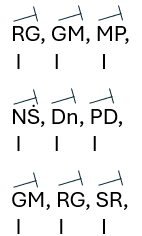
|
An action that involves playing two svaras in quick succession with just one stroke of the mizraab. With the index finger on the first svara, the svara is played with a Da stroke of the mizraab and immediately followed by bringing the middle finger down on the second svara with some force (akin to hammering), so that the second svara is also heard. |

|
Krintan | Krintan |
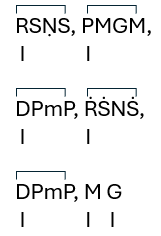
|
A krintan is a complex melodic phrase that is produced by a combination of a ched, ghaseet and aaghaata in quick succession, with or without a stroke of the mizraab. In the example phrase RSNS shown on the left, the krintan is played with a ched from R to S, a ghaseet from S to Ṇ and an aaghaata from Ṇ to S. |